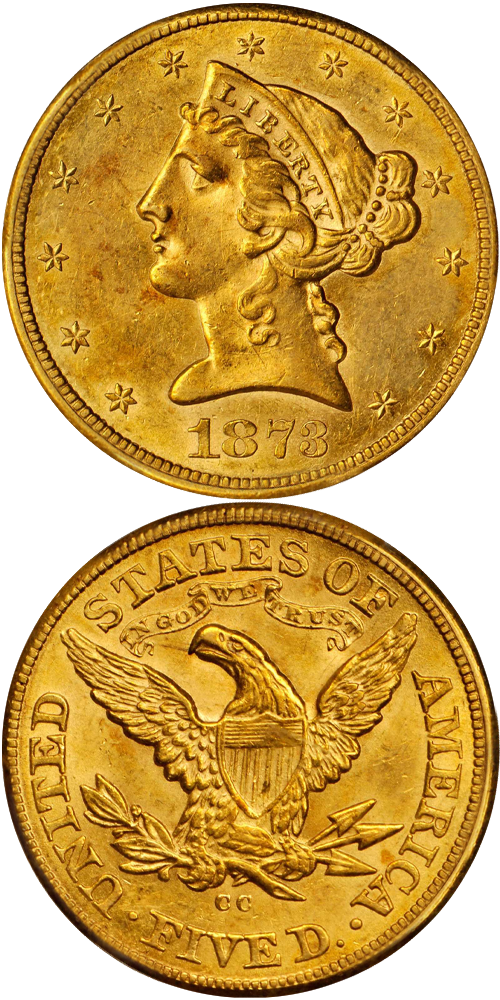1873-CC Liberty Head Half Eagle
Jeff Ambio: The 1873-CC is the earliest dated Carson City Mint half eagle for which multiple obverse dies are known to have been used in striking the issue. Obverse 2 (as defined by Doug Winter in the 2001 book Gold Coins of the Carson City Mint) has the digits in the date somewhat widely spaced and slanting down from left to right. Reverse B of the issue displays the CC mintmark somewhat level, relatively low in the field and closer to the letters VE in FIVE than noted on examples struck from reverse A.
Rusty Goe: In his annual report for 1873, newly appointed Director of the Mint H.R. Linderman said, "Congress acted wisely in establishing gold as the sole standard of value," in the United States. He went on to say that, "The gradual adoption of the gold standard, and consequent demonetization of silver, will of course be followed by an increase in the value of gold...." Linderman's comments of course pertained to the recently passed Coinage Act of 1873, which abolished the standard silver dollar and secured gold's supremacy. One five-dollar piece, a half eagle, represented the limit of value a U.S. citizen could use silver coins as legal tender to pay a debt. People could use unlimited quantities of gold coins for payment of anything, as was demonstrated more clearly in the West than anywhere else in the United States.
The Carson City Mint continued to coin gold pieces in 1873, but only in limited quantities because the production of silver dimes, quarters, halves, and the new trade dollars took priority. The coining department delivered no half eagle gold pieces in the first half of 1873, and then contributed 7,416 sometime between July and December. This was the lowest annual output of $5 gold pieces in the Carson Mint's first four years of business.
Only two Mint State examples are known today. Numismatic Guaranty Corporation rated one of them MS-62, an upgrade from the MS-61 grade PCGS had originally assigned it. Professional Coin Grading Service awarded the Battle Born specimen offered here an MS-62 rating many years ago.
Q. David Bowers: Rusty Goe estimates that 85 to 95 1873-CC half eagles exist, with two Uncirculated, this slightly more liberal than my estimate or that of Doug Winter and Jim Halperin (see below). Once again we are confronted with a first-class rarity, a Carson City half eagle that was minted, and then spent, and in time taken out of circulation. Most went to the melting pot. The typical grade seen is VF, and such pieces are scarce. EF coins are rare, and AU specimens are rarer yet. This is one of the very rarest Carson City half eagles.
I could quote a long string of early auction appearances, but take my word that lower-grade coins were the rule with hardly any exceptions. In 1893 when Augustus G. Heaton wrote his Mint Marks treatise, he knew of not a single numismatist anywhere who collected branch mint gold coins of the higher denominations! Heaton was well connected, was a prominent numismatic writer and researcher of his time, and wrote with authority. Finally, when Carson City coinage did become popular -- years later -- any pieces that could be taken from bank holdings or deposits were apt to be well worn.
The 2001 book, Gold Coins of the Carson City Mint, by Douglas Winter and James L. Halperin, included this about the 1873-CC: "There are only a handful of Liberty Head half eagles that can compare to the 1873-CC in terms of overall rarity and, in particular, rarity in high grades..." Further, from the same author: "The quality of strike is among the poorest for any Carson City half eagle. Virtually all known examples are very flat at the top of the hair and on the bun of Liberty,..."
It would seem that the present specimen, with striking features as noted, is somewhat finer than might typically be encountered. We estimate that only about 45 to 65 are known today, of which perhaps two or three are in lower Mint State levels. In keeping with other Carson City gold coins, there was relatively little interest in collecting such things until well into the 20th century. Regular auction appearances began in earnest in the 1940s, during which time there was a hobby-wide surge in interest in Liberty gold coins, the reasons being complex, but based partly upon the realization during World War II that high denominations represented an excellent store of value.
The example to the left was sold by Stack's Bowers Galleries in the August 2018 Philadelphia ANA Auctiobn, where it realized $168,000.






